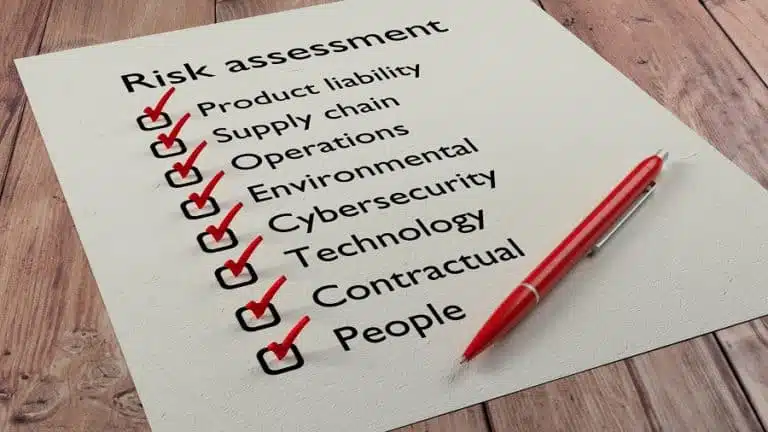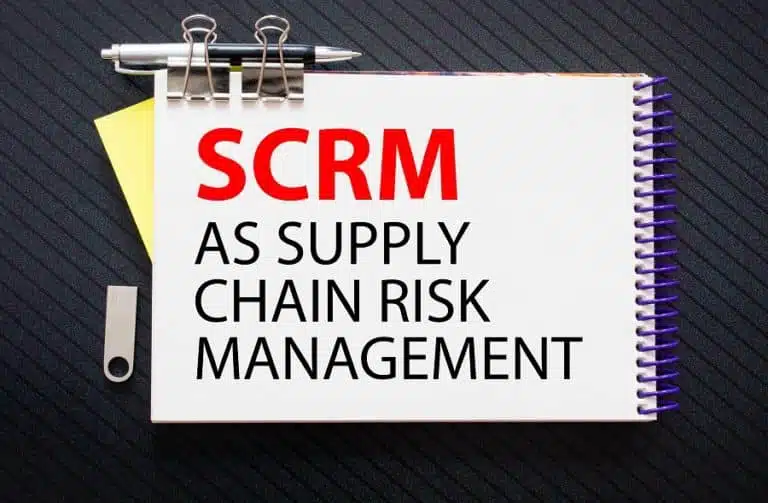Just as physical items reach store shelves through suppliers – information, communications, and operational technology (ICT/OT) rely on a global and interconnected supply chain ecosystem to deliver solutions. But unlike physical supply chains, damage to a cyber supply chain can put more than just the original supplier at risk. Cyber supply chain attacks happen when a hacker or malicious actor uses a third-party supplier such as a partner or provider to infiltrate an organization.
Your supply chain may leave your organization vulnerable to threats you never even knew existed, and controlling what goes on in a third-party provider’s supply chain is particularly challenging. Vulnerabilities inherent to the chain or deliberately introduced by malicious actors can be exploited at any point, making it challenging to identify and manage vulnerabilities.
A survey from Statista reveals that 53% of companies with over $1 billion in revenues reported that their supply chain posed a greater risk to their organization’s security than the organization poses to suppliers. Additionally, a report from the Ponemon Institute indicates that 59% of organizations fall victim to data breaches caused by third-party vendors.
Although controlling your supply chain’s security may seem complicated, implementing cyber supply risk assessment techniques can help you maintain a secure supply chain.

What is a Cyber Supply Chain Risk Assessment?
Relying on third-party supply chains is unavoidable, but there are risks inherent in the practice. For example, third parties may not have the standards of security you require or may be subject to foreign influences or threats. Additionally, access controls to third-party supply chains are out of your control. Your supplier’s liberal access privilege policy may be putting your organization’s reputation, finances, and compliance with privacy regulations at risk.
Cyber Supply Chain Risk Management (C-SCRM) identifies, assesses, and neutralizes the risks associated with the IT/OT product and service supply chain. The technique addresses built-in and deliberately added threats and vulnerabilities that have the potential to compromise the security of a product or service at all stages of the lifecycle.
Regulatory bodies such as NIST (National Institute of Standards and Technology) have created actionable standards, tests, guidelines, and metrics to act as a framework for implementing cyber security supply chain risk assessment. Organizations from various sectors rely on official frameworks and the best practices they include for proper risk assessment implementation.
The NIST first released its original guideline in 2016, but this version was followed by an updated paper released in 2021. Some of the best practices included in the most recent guidelines focus on:
- Foundational practices: The NIST guideline uses existing security practices already embedded in the supply chain as a foundation for building risk assessment programs
- Enterprise-wide practices: According to the NIST, an effective cyber supply chain risk assessment program must encompass the whole lifecycle and include the involvement of all enterprise personnel.
- Critical systems: A practical and affordable risk assessment program requires organizations to categorize and prioritize systems by risk and vulnerability and the threat they pose to the organization.
- Risk management processes: The risk assessment program should be a part of broader risk management activities that include identifying risks and developing strategies for risk management.
What needs to be in a Cyber Supply Chain Risk Assessment?
Cyber supply chain risk assessment gives your team agency over third-party security. By implementing the practices involved in a proper risk assessment program, you can grow your organization’s awareness of vulnerabilities, analyze the vulnerabilities and the risks they pose to your organization, and create strategies designed to address these vulnerabilities.
Empowering your team to play a significant role in your organization’s security impacts your entire organizational culture. Still, a risk assessment should only be one facet of your complete organizational risk management strategy. While it’s important to acknowledge that third-party supply chains have their unique vulnerabilities, this shouldn’t blind you and your team from recognizing broader risks your company faces as a whole and implementing a more comprehensive organizational risk management strategy to ensure that your company remains as protected as possible on all fronts.
A cyber supply chain risk assessment of each threat should include:
- Threat event: What type of event is the threat? For example, a cyberattack from an external threat actor.
- Threat source: What is the source of the threat? For example, internal web applications.
- Threat source characteristics: What characteristics are typical of a threat coming from a specific source?
- Relevance: How relevant is the threat to your organization?
- Likelihood of attack: How likely is it that the threat/ attack will actually happen?
- Severity of vulnerability: How severe would it be to be vulnerable to this threat?
- Likelihood of attack success: How likely is it that if you were attacked, the attack would be successful?
- Level of impact: Measure the level of impact such an attack would have.

8 Key Elements of a Cyber Supply Chain Risk Assessment
1. Start with awareness across the organization
Before you can begin assessing risks, you need to examine each service provider in your supply chain. While this may sound simple, you may discover a complex network of interconnected business relationships you were unaware of on closer examination. Awareness and visibility are essential for allowing you to keep track of where your organization’s data goes and who can access it.
Additionally, it allows you to assess your vendor relationships and each vendor’s importance. With these insights, you can categorize vendors based on risk and their value to your organization. Remaining aware and conscious of potential security risks prevents you from being blindsided, and you can get your entire organization involved. The more staff you prepare with risk awareness training and other educational programs, the more eyes you’ll have spotting vulnerabilities.
2. Establish a program that is continuously updated
As we’ve established, general organizational awareness of cybersecurity risks is essential, but awareness requires knowledge. Providing an engaging and informative educational curriculum to build the general staff’s understanding of cybersecurity risks, both in your supply chain and generally, will keep employees involved and aware and give them a sense of responsibility for your organization’s security and general wellbeing.
Keeping this program regularly updated keeps it fresh and engaging and allows your curriculum to evolve and cover new developments in the cybersecurity world. Regularly renewing and refreshing employee training programs is one of the requirements needed to create an effective employee security training program.
3. Identify and document supply chain risks for your organization
Once your employees know what they’re looking for, they can help identify and locate risks that threaten your organization and assets within your supply chain. These risks may come from a supplier’s inadequate security or be a deliberate attempt at accessing your organization’s assets. Identifying the threat allows you to implement the correct mitigation actions and security measures to neutralize the current threat and prevent future vulnerabilities. In addition, documenting the threat and a plan of action gives you information to share with suppliers, and gives them a guideline on improving security from their end.
4. Assess your supply chain’s risk posture
While you probably already have measures to determine your vendor’s suitability, many of the tools generally used for these purposes don’t present a complete picture of the risks your organization may face and are costly and time-consuming. For example, penetration tests may uncover hidden risks, but they are prohibitively expensive and challenging to implement. Continuous monitoring solutions can fill in the gaps and provide a real-time big picture view of each supplier’s security posture. Then, based on the score given by the solution, you can identify the vendors that require a more profound risk assessment. These tools can also track a vendor’s performance over extended periods.
5. Set pre-procurement standards across the company
While technological solutions play an essential role in your supply chain cybersecurity risk assessment strategy, implementing strong cybersecurity due to diligence practices before onboarding third-party vendors is one of the surest ways of reducing the risks they may present. You can use the metrics from technological solutions such as scores given by monitoring programs to create a minimum threshold of security that vendors must meet before moving forward.
6. Create a questionnaire for all suppliers during the onboarding process
Security questionnaires are an excellent way of assessing vendors during the onboarding process. By giving potential vendors a security questionnaire, you can gain an accurate view of their security standards and ensure that they meet your organization’s needs. It’s essential to ensure you ask the correct questions to confirm the answers you get are accurate and that the vendor aligns with your requirements.

7. Address fourth-party risks
Supply chain risk assessment doesn’t need to begin or end with third parties. To ensure you’re fully protected from cyber risks, you need to be aware of and mitigate fourth-party risk. Fourth-party refers to your vendors’ subcontractors, those subcontractors’ subcontractors, etc. If your vendor becomes compromised by one of their subcontractors, your security is equally at stake. While this is highly complex to keep track of, you must cover all your bases when assessing supply chain risks.
8. Monitor your vendors continuously
Continuous monitoring helps manage third-party risk and mitigates fourth-party risk, giving you unique insight into your entire vendor ecosystem. These insights can alert you to parties you weren’t even aware of and allows you to quickly identify risks within your supply chain, allowing you to alert vendors and collaborate to mitigate the challenge. In addition, effective monitoring software will make you aware of vulnerabilities before they can impact your organization.
Awareness Training can mitigate Supply Chain Cyber Risk
While all these methods have their advantages and can be implemented in various ways, empowering your employees with the knowledge and tools they need to identify risks on their own is the ideal way to recognize and report risks. This creates a culture of risk awareness across your entire organization and allows you to create a human firewall. CybeReady offers cybersecurity awareness training to prepare your staff for every vulnerability they may encounter. Their engaging, exciting training programs give the staff from all departments the tools they need to take the initiative for their organization’s security. Check out the company website to learn more.













